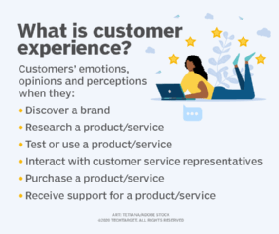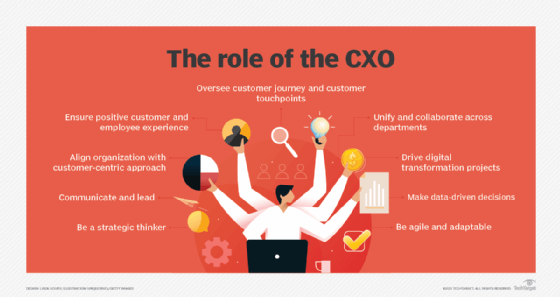
What is a chief experience officer (CXO)?
A chief experience officer (CXO) is an executive in the C-suite who ensures positive interactions with an organization's customers. The CXO typically reports to the chief executive officer, chief operating officer (COO) or chief marketing officer (CMO). A CXO is primarily responsible for overseeing an organization's customer experience (CX) strategy, fostering brand and customer loyalty and ensuring a customer-centric approach to business operations.
Many successful organizations make customer experience a priority. They cite benefits such as increasing customer retention and enhancing their competitive edge. The CXO typically collaborates across departments to implement customer experience initiatives and align the departments and customer touchpoints to ensure positive customer experiences.

What a CXO does
One of the primary goals of a CXO is to provide positive customer experience and continually improve on existing CX programs. Chief experience officers communicate the value proposition of the organization because it's what makes customers choose one company over others. They do this by using the customers' language and interacting with customers through their preferred communication channels.
A CXO typically has oversight of an entire customer journey. A crucial step in accomplishing this is creating a customer journey map. Customer journey maps are a diagram or multiple diagrams that depict the stages customers go through when interacting with a company. Customer journey maps serve the following functions:
- They provide data-driven insight.
- They help create positive interactions between companies and individuals.
- They predict the path of future customers.
In the enterprise, the CXO oversees a team that monitors customer interactions and assures that the company is adequately responding to complaints, concerns and suggestions for improvement. Businesses interact with their customers in many ways, including social media platforms, customer feedback forums and customer support; the CXO integrates these channels to ensure a smooth flow of usable information between the enterprise and its customers.
CXOs often get help from data analytics teams, as well as social media management software and teams, to digest the constant flow of data coming from various forms of communication and customer information. Many CXOs also rely on an executive dashboard to monitor these resources and extract customer intelligence useful to the business. CXOs also lead digital transformation projects and ensure that user experience (UX) across customer-facing websites, apps and other technologies is consistent and positive.
Many CXOs handle both employee experience -- the interactions, perceptions and feelings that an employee has with a company, from recruitment to an exit interview -- and CX, with the intent of aligning the two initiatives. This aspect of the CXO role has increased in importance because many experts report there's a strong link between employee engagement and satisfaction and customer satisfaction.
CXO experience and skills
CXOs vary in experience and background. Often, a CXO has a background in operations, marketing, sales, customer service or UX. CXOs often have a Master of Business Administration or other master's degree, as well as proven experience in a managerial or executive role.
Sometimes, a company hires a CXO from within when an employee has a particular interest in CX or is a brand champion. The skills required to be a CXO have some overlap with general must-have skills for any customer experience professional.
CXOs should have superior communication, leadership, problem-solving and people management skills. They also must be big-picture thinkers. Skills that are particularly important to the role include the following:
- Collaborative leadership. Successful CXOs depend on cross-functional teamwork. They should look to foster a collaborative work environment by promoting open communication, encouraging diverse perspectives and creating opportunities for collaboration and stakeholder participation, which can lead to innovative CX approaches.
- Agility and adaptability. Agility and adaptability are core to a CXO's skill set. CXOs should be able to adapt quickly to changing market conditions; emerging technologies, such as artificial intelligence (AI); and evolving customer expectations. They should also be able to embrace Agile methodologies and encourage experimentation and iterative improvements. This lets CXOs respond effectively to customer needs and stay ahead of competition.
- Strategic thinking. A CXO needs to have a strategic mindset and the ability to align CX initiatives with broader business strategies. CXOs should develop strategic thinking by understanding market trends, identifying growth opportunities and anticipating customer needs. This can help align CX, employee experience and key business outcomes to drive sustainable growth and organizational success.
- Data-driven decision-making. Data plays a critical role in CX strategies. CXOs should be proficient in data analysis and interpretation to derive actionable insights. CXOs should invest in data analytics tools and technologies and develop their skills in data visualization and storytelling. This helps them make informed decisions, track key metrics and measure the impact of CX initiatives on business outcomes.

Key CXO responsibilities
A CXO has several key responsibilities, including the following:
- Prioritizing customer experience and driving profitability through CX strategies and the implantation of customer mapping strategies.
- Monitoring key performance indicators (KPIs) to track progress on company goals and projects.
- Managing the company's Net Promoter Score to assess and improve customer loyalty and satisfaction.
- Ensuring the voice of the customer and other key stakeholders is integrated into business decisions, from product development to service delivery.
- Analyzing the business landscape to stay competitive and responsive to market changes.
- Collaborating closely with the COO and the chief financial officer (CFO) to align operational and financial strategies with customer-focused goals.
- Leading teams, including the customer-facing frontline, to deliver an outstanding overall customer experience.
- Understanding customer needs and translating them into actionable business insights.
The benefits of hiring a CXO
Without a CXO, an organization might not have a defined way to extend the customer experience beyond care and support services. CXOs oversee the customer lifecycle, designing and delivering positive experiences. Typically, they are also in charge of increasing customer and employee understanding, prioritizing the customer's viewpoint in decision-making processes and keeping track of KPIs.
Hiring a CXO also represents an attempt to move toward a CX-centric company culture. Good CX requires many departments across the organization to be customer-focused, and CXOs work toward that goal. They align marketing, sales, customer success teams and the C-suite and break down silos that prevent good CX.
The evolution of a CXO
CX is becoming a central focus for many organizations. As digital experiences and interactions rise, customers increasingly expect personalized experiences with brands.
The job title of chief experience officer is increasingly replacing that of the chief customer officer (CCO) and CMO in many organizations. The role of a CXO is generally broader than that of a CCO, especially when it comes to ensuring a positive experience of internal customers, such as employees, suppliers and vendors.
Nearly all organizations have a CXO or CXO equivalent, according to Gartner. This is a significant increase from 2017 when more than 35% of companies didn't have a CXO.
CXO vs. CMO
Customer experience, not marketing, is becoming the main focus for many brands. This has caused some companies to transition the CMO role to a CXO by rebranding the role rather than firing and replacing a CMO. However, many organizations still have both CMO and CXO roles.
Chief marketing officer
Traditionally, the CMO is responsible for driving marketing strategy, which includes understanding the company's position in the market, directing marketing campaigns and overseeing branding strategies. However, the roles of the CXO and CMO often overlap, and CMOs are expected to have skill sets and tools that drive CX strategies.
Chief experience officer
The CXO drives the company's entire CX strategy. This involves mapping customer journeys, overseeing the customer success and customer service teams, and digging into customer data analytics. The CXO is often responsible for improving employee experience and engagement, while a CMO generally doesn't take on that responsibility.
How to become a successful CXO
Becoming a CXO requires a combination of experience, skills and qualifications. Some of the most important ways to prepare for the CXO role are the following:
- Gain experience in CX and UX. Aspiring CXOs should build strong foundations in CX and UX principles. This involves working in roles that enable them to understand customer needs and behaviors on platforms like social media, conduct user research and design intuitive user interfaces.
- Develop leadership skills. CXOs are responsible for leading cross-functional teams and collaborating with other C-level executives. Potential CXOs should increase their leadership abilities by taking on managerial roles when the opportunity arises, attending leadership development programs and seeking mentorship from experienced professionals.
- Acquire business acumen. CXOs must have a deep understanding of their organization's business goals, objectives and various departmental functions. To get this, they should seek out experience in areas where the business's CX strategy must align, such as marketing, finance, operations and data analytics.
- Foster collaboration and partnership. Collaboration is essential for a CXO to succeed. CXOs should cultivate strong partnerships with other C-level executives, such as the CFO, CMO, chief information officer and chief human resources officer. This helps CXOs gain buy-in for CX initiatives and ensure the integration of CX into all aspects of the organization.
- Stay on top of industry trends. CXOs should attend conferences and webinars, as well as read relevant publications, to monitor the latest CX trends, technologies and best practices. This can help them expand their knowledge, drive innovation and retain a competitive advantage.
How to hire a CXO
There are several important steps organizations should follow when hiring a successful CXO, including these four:
- Define the role clearly. Organizations identify the needs they want a CXO to address, including important metrics, like profitability and CX. They should describe the CXO role to clearly express these goals.
- Identify customer-centric leaders. Hiring managers prioritize candidates who demonstrate a commitment to building a customer-centric culture and who have experience integrating CX metrics and feedback into business strategies.
- Assess leadership skills. A successful CXO has strong leadership skills to work cross-functionally with C-suite members, while also managing frontline teams effectively.
- Evaluate analytical capabilities. Top candidates are data-driven and able to interpret KPIs to guide the company's overall strategy.
Future of the CXO role
The role of a CXO is dependent on the evolving nature of customer experience. As CX changes, the CXO position and job description will also change. Some important trends that could affect the CXO role include the growth of AI and automation. These technologies are already changing the speed and accuracy of analytics-based customer profiles. CXOs must understand them to lead personalization, automation and other future projects.
At the same time, CXOs must balance increased use of AI and automation with ethical and responsible CX practices. As data privacy, security and responsible AI concerns grow, CXOs have to ensure ethical and responsible handling of customer data to build trust with customers. CXOs play a critical role in driving ethical CX practices and maintaining transparency in data collection and use.
A successful customer experience officer must stay on top of customer experience trends. Learn how Gen Z will change the future of customer experience.






